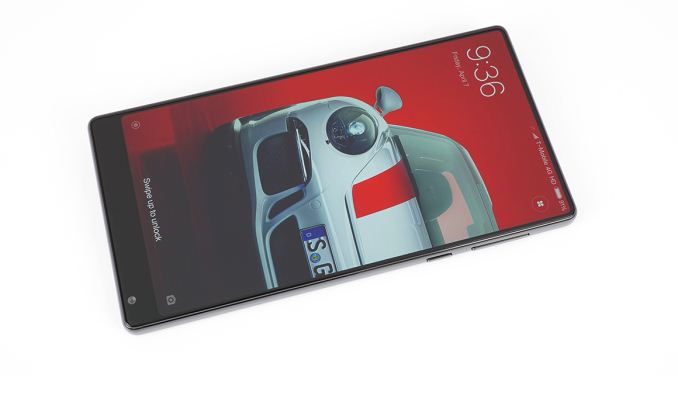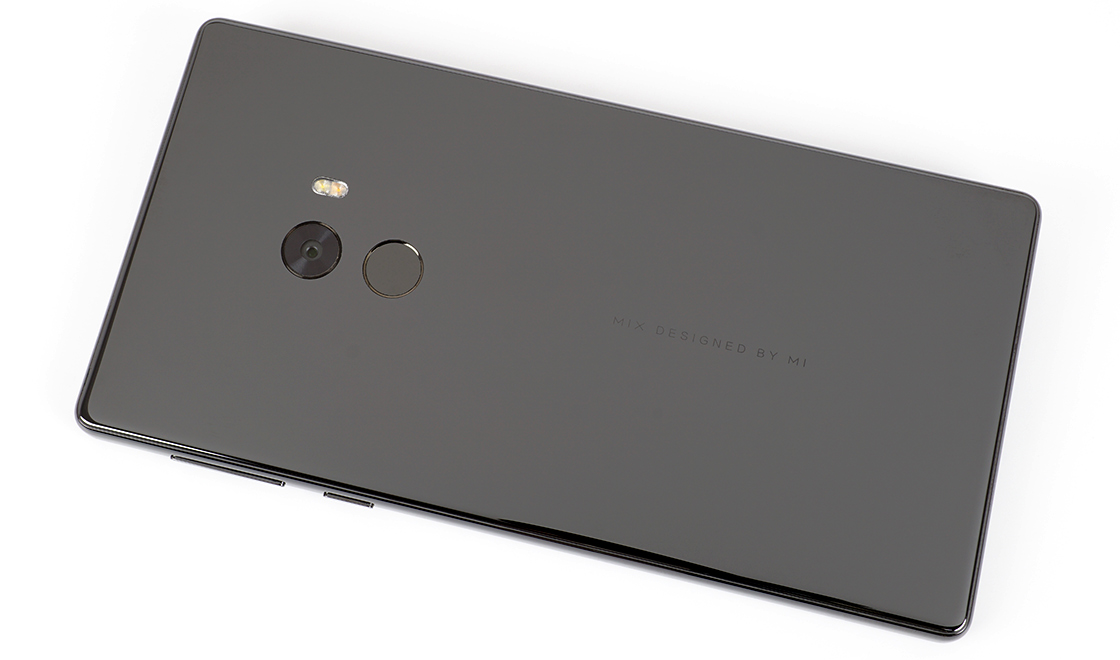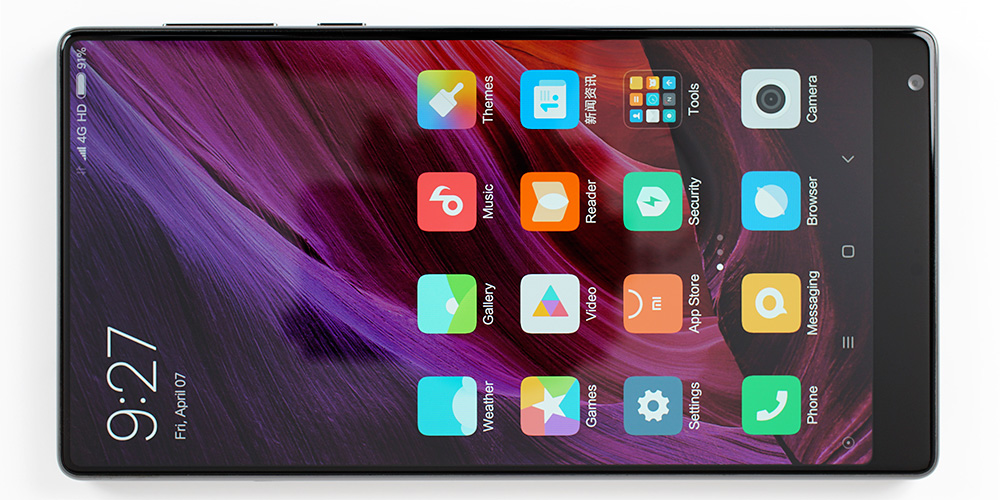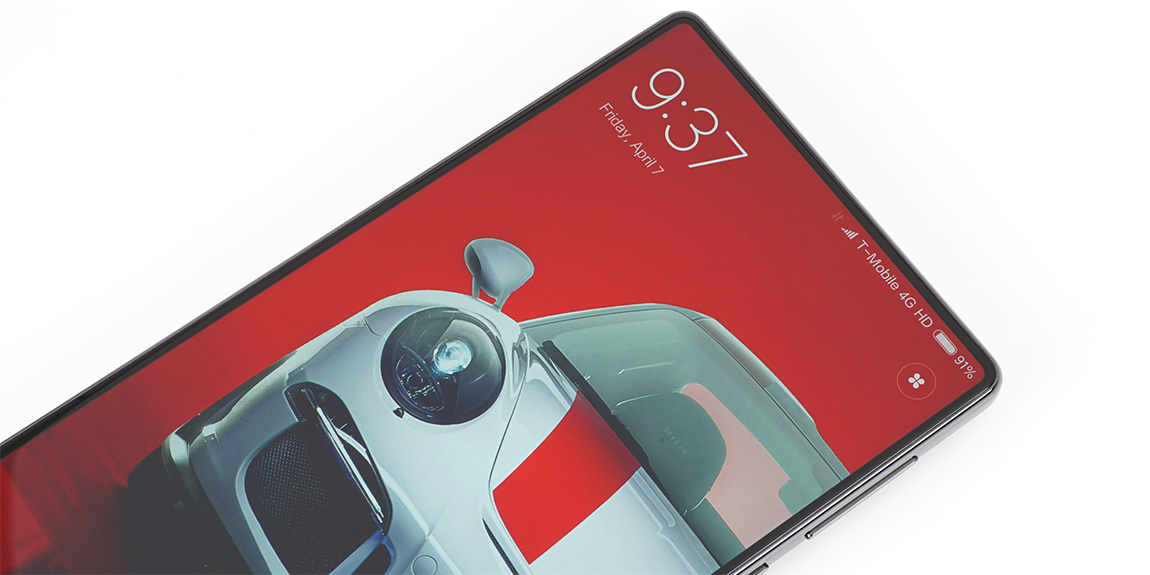Xiaomi Mi MIX: A Closer Look at the Design and Display
by Matt Humrick on April 10, 2017 7:00 AM EST- Posted in
- Smartphones
- Mobile
- Xiaomi
- Mi
- Snapdragon 821

We recently saw the release of two new smartphones with dramatically improved screen-to-body ratios, the LG G6 and Samsung Galaxy S8. Before either of these phones were announced, however, Xiaomi’s Mi MIX gave us a glimpse of the future. A pseudo-concept phone that’s being produced in limited quantities and sold in China, it combines the latest technology with innovative design, resulting in a forward-looking phone with virtually no bezels on three sides of the screen and an amazing 91.3% screen-to-body ratio, according to Xiaomi (or roughly 84% using the chassis dimensions).
Xiaomi created the Mi MIX to show off its design prowess and demonstrate its ability to produce innovative products. Xiaomi has employed new materials (ceramic) and design elements (rounded edges on the back) in the past, but by creating something as unique as the MIX, it hopes to prove that its products are as lust worthy as those that come from Apple and Samsung.
Competition among Chinese OEMs is fierce, with most of them sacrificing smartphone profit for market share. Xiaomi in particular has a reputation for creating nice-looking phones packed with high-performing hardware that are sold at lower-than-expected prices, compensating for the near-zero profit from hardware sales with recurring revenue earned through its software ecosystem. This strategy has helped fuel its rapid growth, but as the smartphone market in Asia nears saturation, it may be time to shift its focus. Xiaomi has been aggressively diversifying its product portfolio, branching out into smart home devices, UAVs, bicycles, etc., and pushing into western markets where premium phones fetch higher profit. By creating a flashy product like the MIX, Xiaomi attracts attention and improves its brand cachet, which can help it break into new markets and establish itself as a premium player that can charge more for its phones.
Encased within the shiny ceramic is a Snapdragon 821 SoC and a large 4400 mAh battery. There’s also either 4GB of RAM and 128GB of internal storage for the standard MIX or 6GB of RAM and 256GB of storage for the Mi MIX 18K. Both configurations offer flagship-class performance.
In the short time I’ve used the MIX, the only component I’ve had issues with is the fingerprint sensor. It seems less tolerant of moisture than other sensors and returns a higher rate of false negatives. It’s certainly usable, but I often found it required two or three tries to unlock the phone.
| Xiaomi Mi MIX | |
| SoC | Qualcomm Snapdragon 821 (MSM8996 Pro) 2x Kryo @ 2.35GHz 2x Kryo @ 2.19GHz Adreno 530 @ 653MHz |
| Display | 6.4-inch 2040x1080 IPS LCD |
| Dimensions | 158.8 x 81.9 x 7.9 mm 209 grams |
| RAM | 4GB / 6GB LPDDR4 |
| NAND | 128GB / 256GB (UFS 2.0) |
| Battery | 4400 mAh (16.94 Wh) non-replaceable Qualcomm Quick Charge 3.0 |
| Front Camera | 5MP, 1/5" OmniVision OV5675 PureCel, 1.12µm pixels, f/2.2 |
| Rear Camera | 16MP, 1/3.06" OmniVision OV16880 PureCel Plus-S, 1.0µm pixels, f/2.0, PDAF, Auto HDR, dual-tone LED flash |
| Modem | Qualcomm X12 LTE (Integrated) 2G / 3G / 4G LTE (Category 13/12) |
| SIM Size | 2x NanoSIM (dual standby) |
| Network | China |
| FDD-LTE | B1 / B2 / B3 / B4 / B5 / B7 / B8 |
| TDD-LTE | B38 / B39 / B40 / B41 |
| GSM | 850 / 900 / 1800 / 1900 |
| WCDMA | B1 / B2 / B5 / B8 |
| CDMA | BC0 |
| TD-CDMA | B34 / B39 |
| Wireless | 802.11a/b/g/n/ac 2x2 MU-MIMO, BT 4.2, NFC, GPS/GNSS/Beidou |
| Connectivity | USB Type-C, 3.5mm headset |
| Launch OS | Android 6.0 with MIUI 8 |
| Launch Price | 4GB/128GB: ¥3499 6GB/256GB: ¥3999 |
The MIX’s 6.4-inch IPS LCD display has a 17:9 aspect ratio, which Xiaomi divides into a traditional 16:9 viewable area with a dedicated space at the bottom of the screen for the onscreen controls. Not only does this eliminate the need for capacitive buttons in the lower bezel—keeping it as slim as possible—but it avoids UI scaling issues for apps targeting 16:9 screens.
Our review unit uses a Sharp fte716 IPS LCD panel that appears to use IGZO (indium gallium zinc oxide) thin-film transistors (TFTs) in the backplane. IGZO transistors have several advantages over the amorphous silicon (aSi) or low-temperature polysilicon (LTPS) varieties.
Every liquid crystal (LC) requires circuitry, including a transistor and a capacitor, to control its operation. These components can block some of the light transmission from the backlight, however, reducing the display’s power efficiency. The more light that passes through the backplane, the less power the backlight needs to consume to reach a given brightness.
Most IPS LCD panels use aSi TFTs. These are not naturally transparent, although, they can be made thin enough to allow at least some light to pass through them. IGZO TFTs, however, are fully transparent, which improves power efficiency by allowing more light to pass through.
IGZO’s electron mobility is also significantly higher than aSi and almost as good as LTPS, which allows smaller transistors to carry the same current. The MIX’s panel uses the smaller TFTs to increase the aperture ratio (the ratio of a pixel’s transparent and opaque areas), which further improves efficiency by allowing more light to pass through.
Most LCD displays need to continually refresh the screen, even when displaying a static image, because high leakage current in aSi and LTPS TFTs causes the capacitors in the pixels to discharge. Continuously driving the pixels in this manner increases power consumption, not just within the panel itself, but also by forcing the SoC to continuously push the contents of the frame buffer over the memory bus. To help mitigate this issue, some panels support panel self-refresh (PSR), which embeds a small amount of RAM in the panel itself to hold a local copy of the frame buffer. When displaying a static image (which is most of the time when not playing a game or watching a video), the panel can use its local copy to refresh the screen, reducing the power the SoC and busses would normally consume.
The Mi MIX’s panel does not support panel self-refresh, which would normally be a serious omission for a flagship phone; however, IGZO TFTs have significantly less leakage current than aSi and LTPS, allowing their pixels to discharge more slowly and retain their image state longer. A technology called idling-stop driving (IDS) takes advantage of this by significantly reducing the refresh rate of the screen when displaying static content, essentially achieving a similar power advantage as a display with PSR.
IGZO’s benefits not only reduce a display’s power consumption, but they are directly responsible for the Mi MIX’s most eye-catching feature: its edge-to-edge display. IGZO allowed Sharp to integrate the supporting circuitry that normally surrounds the active area of the screen into the panel itself, allowing Xiaomi to nearly eliminate the bezel on three sides.
The Mi MIX is a stunning looking phone whose nearly edge-to-edge display and shiny ceramic body make it stand out as something special. Xiaomi’s use of ultrasonic and piezoelectric technology streamlines the front by hiding two components—proximity sensor and earpiece speaker—behind the screen, fueling the illusion that you’re holding nothing but a 6.4-inch display. As the phone’s centerpiece, display performance is critical for the Mi MIX, and our analysis on the next page shows that it looks as good as the rest of the phone.













48 Comments
View All Comments
Matt Humrick - Monday, April 10, 2017 - link
I measure the MIX's screen-to-body ratio to be 87.9%. Xiaomi's figure might be a little optimistic, but it seems pretty close to me, and Xiaomi is working from the CAD model rather than measuring a retail device with a caliper.opc - Monday, April 10, 2017 - link
Hi Matt,Thanks for the response. I don't think there's much to measure here... the screen is a 6.4" 17:9 aspect ratio. By definition it has a physical size of 143.67mm x 76.06mm which is a total surface area of 10927.5mm square. The phone itself is 158.8mm x 81.9mm which is a total surface area of 13005.7mm square. This gives an aspect ratio of exactly 84%. Normally you would need to account for the tiny delta caused by the corner radius, but in this case the screen has the same radius, so it won't change anything.
If you take a look at GSM arena, they have it correctly calculated in their spec sheet. I'd be curious to see how you came up with 87.9%.
Finally, "a bit optimistic" might account for less than a 1% error, but even a 3% error is a very big delta. If I showed you a phone with a true 91.3% screen to body ratio your jaw would drop. As it is, Xiaomi published a number that was 7.3% off, and that's the same as the difference between the S7 and the S8!
opc - Monday, April 10, 2017 - link
Oops.. that should read: "This gives a screen to body ratio of exactly 84%."Matt Humrick - Monday, April 10, 2017 - link
Using the frame dimensions, I get pretty close to 84% too. For the 87.9% figure, I measured the "body" as only the flat area of the front bezel and factored in the radii, which I thought might be closer to how Xiaomi is calculating the ratio.Amolsonthalia - Monday, April 10, 2017 - link
Hello been using mi mix for a week,never had a issue with the finger scan,either the OP has sticky hand or is using fingerprint scanner for first time.Mi Mix ticks all the boxes,bought it from an onlien shop gearbest,NO issues running In India,Global Rom is perfect.Now I understand what really is MI is all about and why people are crazy..Innovative.ahadali1 - Tuesday, April 11, 2017 - link
When you think of cheap pine king/ queen size storage beds for children you usually think of either platform beds or loft beds. Murphy beds are too dangerous for children and ottoman storage beds are too complicated, heavy and dangerous. Children need space to play in, and they need comfort and safe environments, which is why purchasing a storage bed for them is a very wise decision.hybrid2d4x4 - Wednesday, April 12, 2017 - link
IMO, the bezel reduction trend this phone may have started is the single biggest improvement in smartphone design in the past few years. I just wish that it wouldn't be applied only to increasing screen size in current form factor phones, but scale back down as well. I'd love a phone with 4.5" screen (3:2 ratio preferably) and the absolute minimum in bezels. This constant march to bigger phones has really been off-putting to the minority of us that want something small and isn't landfill-grade hardware. And I'm talking about overall phone size, not putting a 4" screen in the same size body as flagships with 5-5.2" due to woefully oversized bezels.One thing I hate about the MIX design is the 17:9 screen ratio. To me the dimension of a phone that impacts pocketability most is height, and this just makes it worse.
I just don't get why phones would be designed around 16:9 when all that ratio is really optimal for is watching video (and is ok for playing games) and literally nothing else.
Bigger reported screen size dimension while providing a smaller screen area-wise?
Sorry for the rant...
adsforme2007 - Tuesday, May 16, 2017 - link
Xiaomi Mi Mix one more phone from Mi. i thought this is best for for me but when i compare with Doogee Mix then found som fact. Doogee MIX have sports glass back body with 5.5-inch AMOLED display offering Full HD resolution and comes with on-screen navigation buttons. Doogee MIX packs a MediaTek Helio P25 (MT6757T) octa-core processor. It runs on Android 7.0 Nougat and dual-lens camera setup on the rear with 16MP and 8MP sensors. For selfies, there is a 5MP front camera placed on the bottom bezel of the device. so my choice is Doogee MIX.